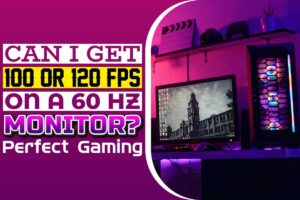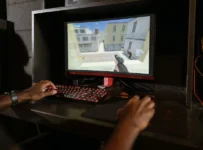
When looking for a gaming computer, you must consider the frame rate of the computer. It’s the frame rate that determines the quality or resolution and graphics of the game.
The frame rate is measured in Frames per Second (FPS). Many gamers believe that a higher frame rate is better in gaming. But that is not the thing.
You will get more insight into this misconception in the later parts of the article. However, the amount of FPS you can get in a game is quite essential.
It will undoubtedly affect both your overall gaming experience and performance. Mostly, when people hear about FPS, they think of the graphic card.
But the FPS is much more than just the graphics card if you have the best gaming PC ever but have a bad monitor.
Your gaming experience will be so incomplete. Having mentioned all this, let’s get back to one of the popularly asked questions.
Can I Get 100 or 120 fps on a 60 Hz Monitor?
No, the 60 fps is the maximum fps that you can get from your 60 Hz monitor. If your game is either 100 or 120 fps, you will only get 60fps plus screen tearing.
This does not mean that your PC will not send 100 or 120 fps to the 60 Hz monitor. The PC will indeed send the 100 and 120 fps to your monitor.
However, the monitor will disregard the extra 40 fps and 60 fps, respectively. You will not be able to see the disregarded fps until you use a monitor that has 100+ Hz.
How Much FPS Can A 60 Hz Monitor Display?
The 60 Hz monitor is the standard gaming monitor. It only can display the frame rates that are below 60 fps. It will do this without any struggles.
If you have a power game and monitor running at a higher fps of, let’s say, 240. Your 60 Hz monitor will only display the 60 fps, and you will experience screen tearing. With screen tearing, you will have a bad gaming experience.
What Is The Frame And Frame Rate?
The frame refers to the single still image. The still image is then combined with other still images in a quick slideshow. The combination helps achieve the natural motion illusion.
The frame rate refers is the amount images displayed in one second. The CPU and the GPU always work hand in hand to produce the perfect image.
The role of the GPU is to cut the image into pixels. It cuts the image according to the resolution that you have set.
After cutting the image, it does send the information to the monitor. Powerful GPU and CPU do generate more frames per second.
What Is The Refresh Rate?
We cannot see it, but our TVs and monitors constantly refresh after every second. The refresh rate is the number of times per second that the screen draws a new image.
The refresh rate is written as Hz (Hertz). If your monitor is 60Hz, it means that the monitor refreshes itself sixty times in each second.
If it has a rating of 120 Hz, then it does refresh 120 times in each second. From the description, I hope you now know the difference between the refresh and frame rate.
How Does The Frame Rate And The Refresh Rate Correlate?
As mentioned, the frame rate is how many times a source sends a new frame per second. So if the source does send 60 FPS, you will need to have a monitor that will be refreshing 60 times per second.
The frame rate and refresh rate should always match to prevent the motion from being blurry. You should note that a 60 Hz monitor will not have any effect on the FPS. However, if the FPS is high, it will undoubtedly cause some issues.
What Is Screen Tearing?
The frame rate and refresh rate are two different things. During certain instances, the two might fail to match, and this leads to screen tearing.
The screen tearing does happen when the video card spits out the frame at a higher rate than the refresh rate of the monitor. The frames from the GPU are more, and the monitor cannot handle them effectively.
During screen tearing, you will see splits, and you will notice the images do not align. Screen tearing is a distracting issue, especially to gamers. I can assure you that even the least sensitive viewer can notice if it does happen.
Games that are not so taxing can have a framerate that is above 100 fps. If you own a monitor of 60 Hz, this means it can only refresh 60 times per second.
Therefore if you play a game that has 60+ fps, you will not fully benefit. It’s because this screen will not offer you the enhanced responsiveness that you deserve.
You certainly notice screen tearing since the monitor cannot keep up with the data being fed to it. It would be best if you always went for a monitor with a higher refresh rate.
This type of monitor will always be able to match up and handle the different frame rates. You should note that screen tearing does not in any way damage the graphic card or display.
Preventing screen tearing is possible. All you need to do is enable the vertical synchronization feature, also referred to as VSync. The feature commands the GPU to synchronize its actions with the monitor.
The Refresh Rates To Choose For Your Gaming Monitor
A monitor that has a high refresh rate will guarantee smooth images. A clean and smooth display is one of the essential things in gaming.
There is a different screen refresh rate for every game. That’s from the novices gamers to professional gamers. Let’s take a look at the one that best fits your gaming.
The 60 Hz Monitor: The Perfect Choice for Novice Gamers
The 60 Hz monitor can display 60 images in each second. The 60 Hz monitor is considered to be the standard gaming screen by most gamers.
With this monitor, you do not need to have an expensive video card. The middle-end video cards will ensure the monitor produces. All this is what makes the 60 Hz monitor ideal for novice gamers.
It works well with simple games such as Minecraft, which do not have many moving images. Other adventure games such as GTA V and Assassin Creed can also run on the 60Hz screen. However, it should be high-end.
The 75 Hz Monitor: Ideal For Novice Gamers That Play Shooter
This monitor is undoubtedly more powerful and faster than the 60 Hz monitor. It’s because, with the 75 Hz monitor, you get 25% more images.
This monitor is enough for you to win against your opponent in a racing or shooter game. The professional gamers will undoubtedly feel like it’s not that fast.
However, the novice gamer will not be able to notice any difference. It is the perfect monitor for anyone who plays the mentioned games.
Plus, if you need to upgrade the 60Hz without spending many dollars, you can go for it.
The 144 Hz Monitor: For Experienced Gamers
It’s the perfect gaming monitor for experienced gamers. It’s because it has a very smooth display of images.
With the 144 Hz screen, you will smoothly play fast-paced games like God of war and many more. It’s easy to notice the difference between 60 Hz and 144 Hz. Even the novice gamer can notice the difference.
In the 60 Hz screen, tearing is a pervasive thing, and you will experience t regularly. But when it comes to the 144 Hz, I can assure you will not experience screen tearing. However, the 144 Hz monitor is a little bit pricey, but it guarantees you good graphics.
The 240 Hz Monitor: It’s The Best For E-Athletes and Diehard Gamers
If you are a novice gamer, you will hardly notice the difference between 144 Hz and 240 Hz. Only the diehard gamers and those who participate in the e-sports tournaments can notice this.
The 240 Hz offers life-like motion quality. The image is relatively sharper and more up-to-date with the surrounding.
If you are a professional gamer, this monitor is perfect for you. It will undoubtedly give you an upper hand against your competitors.
The Hardware You Need For Gaming
I have already talked about the perfect gaming monitors. However, the monitors alone will not make your gaming experience perfect.
You need to have a complete set of gaming hardware. The rule of choosing gaming hardware is quite a symbol. The higher the Frame rate, the more powerful your video card is supposed to be.
That means you need to own a better video card of 144Hz/ 144 fps and above for gaming. The 60 Hz/ 60fps is better for watching movies and playing simple games.
Conclusion
The graphics card, memory, processor, and hard drive function to give a balanced gaming system. However, the monitor is also a significant factor when it comes to gaming.
It’s through the monitor that you will be able to realize the gaming performance. It’s responsible for the display, and therefore you should ensure the monitor is of high quality. This will guarantee a smooth and clean display.


